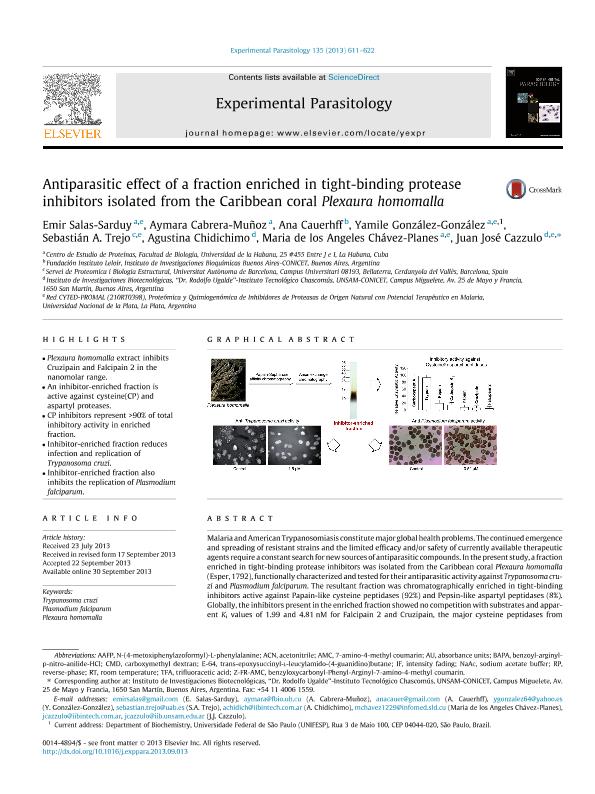Mostrar el registro sencillo del ítem
dc.contributor.author
Salas Sarduy, Emir
dc.contributor.author
Cabrera Muñoz, Aymara
dc.contributor.author
Cauerff, Ana Albina

dc.contributor.author
González González, Yamile
dc.contributor.author
Trejo, Sebastian Alejandro
dc.contributor.author
Chidichimo, Agustina
dc.contributor.author
Chávez Planes, Maria de Los Angeles
dc.contributor.author
Cazzulo, Juan Jose

dc.date.available
2016-02-19T18:44:33Z
dc.date.issued
2013-09-30
dc.identifier.citation
Salas Sarduy, Emir; Cabrera Muñoz, Aymara; Cauerff, Ana Albina; González González, Yamile ; Trejo, Sebastian Alejandro; et al.; Antiparasitic effect of a fraction enriched in tight-binding protease inhibitors isolated from the Caribbean coral Plexaura homomalla; Elsevier; Experimental Parasitology; 135; 3; 30-9-2013; 611-622
dc.identifier.issn
0014-4894
dc.identifier.uri
http://hdl.handle.net/11336/4318
dc.description.abstract
Malaria and American Trypanosomiasis constitute major global health problems. The continued emergence and spreading of resistant strains and the limited efficacy and/or safety of currently available therapeutic agents require a constant search for new sources of antiparasitic compounds. In the present study, a fraction enriched in tight-binding protease inhibitors was isolated from the Caribbean coral Plexaura homomalla (Esper, 1792), functionally characterized and tested for their antiparasitic activity against Trypanosoma cruzi and Plasmodium falciparum. The resultant fraction was chromatographically enriched in tight-binding inhibitors active against Papain-like cysteine peptidases (92%) and Pepsin-like aspartyl peptidases (8%). Globally, the inhibitors present in the enriched fraction showed no competition with substrates and apparent Ki values of 1.99 and 4.81 nM for Falcipain 2 and Cruzipain, the major cysteine peptidases from P. falciparum and T. cruzi, respectively. The inhibitor-enriched fraction showed promising antiparasitic activity in cultures. It reduced the growth of the chloroquine-resistant P. falciparum strain Dd2 (IC50 = 0.46 μM) and promoted the apparent accumulation of trophozoites, both consistent with a blockade in the hemoglobin degradation pathway. At sub-micromolar concentrations, the inhibitor-enriched fraction reduced the infection of VERO cells by T. cruzi (CL Brener clone) trypomastigotes and interfered with intracellular differentiation and/or replication of the parasites. This study provides new scientific evidence that confirms P. homomalla as an excellent source of tight-biding protease inhibitors for different proteases with biomedical relevance, and suggests that either the individual inhibitors or the enriched fraction itself could be valuable as antiparasitic compounds.
dc.format
application/pdf
dc.language.iso
eng
dc.publisher
Elsevier

dc.rights
info:eu-repo/semantics/openAccess
dc.rights.uri
https://creativecommons.org/licenses/by-nc-nd/2.5/ar/
dc.subject
Trypanosoma Cruzi
dc.subject
Plasmodium Falciparum
dc.subject
Plexaura Homomalla
dc.subject
Cysteine Peptidases
dc.subject
Tight-Binding Inhibitor
dc.subject
Antiparasitic Agents
dc.subject.classification
Bioquímica y Biología Molecular

dc.subject.classification
Ciencias Biológicas

dc.subject.classification
CIENCIAS NATURALES Y EXACTAS

dc.title
Antiparasitic effect of a fraction enriched in tight-binding protease inhibitors isolated from the Caribbean coral Plexaura homomalla
dc.type
info:eu-repo/semantics/article
dc.type
info:ar-repo/semantics/artículo
dc.type
info:eu-repo/semantics/publishedVersion
dc.date.updated
2016-03-30 10:35:44.97925-03
dc.journal.volume
135
dc.journal.number
3
dc.journal.pagination
611-622
dc.journal.pais
Países Bajos

dc.journal.ciudad
Amsterdam
dc.description.fil
Fil: Salas Sarduy, Emir. Universidad de la Habana. Facultad de Biología. Centro de Estudio de Proteínas; Cuba. Universidad Nacional de la Plata. Red CYTED-PROMAL. Proteómica y Quimiogenómica de Inhibidores de Proteasas de Origen Natural con Potencial Terapéutico en Malaria; Argentina
dc.description.fil
Fil: Cabrera Muñoz, Aymara. Universidad de la Habana. Facultad de Biología. Centro de Estudio de Proteínas; Cuba
dc.description.fil
Fil: Cauerff, Ana Albina. Fundación Instituto Leloir; Argentina. Consejo Nacional de Investigaciones Científicas y Técnicas. Oficina de Coordinación Administrativa Parque Centenario. Instituto de Investigaciones Bioquimicas de Buenos Aires; Argentina. Consejo Nacional de Investigaciones Científicas y Técnicas. Centro Científico Tecnológico la Plata. Centro de Investigación y Desarrollo en Fermentaciones Industriales (i); Argentina
dc.description.fil
Fil: González González, Yamile . Universidad de la Habana. Facultad de Biología. Centro de Estudio de Proteínas; Cuba. Universidad Nacional de la Plata. Red CYTED-PROMAL. Proteómica y Quimiogenómica de Inhibidores de Proteasas de Origen Natural con Potencial Terapéutico en Malaria; Argentina
dc.description.fil
Fil: Trejo, Sebastian Alejandro. Universitat Autònoma de Barcelona. Servei de Proteomica i Biologia Estructural; España. Universidad Nacional de la Plata. Red CYTED-PROMAL. Proteómica y Quimiogenómica de Inhibidores de Proteasas de Origen Natural con Potencial Terapéutico en Malaria; Argentina
dc.description.fil
Fil: Chidichimo, Agustina. Instituto de Investigaciones Biotecnológicas - Instituto Tecnológico Chascomús (San Martin); Argentina
dc.description.fil
Fil: Chávez Planes, Maria de Los Angeles. Universidad de la Habana. Facultad de Biología. Centro de Estudio de Proteínas; Cuba. Universidad Nacional de la Plata. Red CYTED-PROMAL. Proteómica y Quimiogenómica de Inhibidores de Proteasas de Origen Natural con Potencial Terapéutico en Malaria; Argentina
dc.description.fil
Fil: Cazzulo, Juan Jose. Instituto de Investigaciones Biotecnológicas - Instituto Tecnológico Chascomús (san Martin); Argentina. Universidad Nacional de la Plata. Red CYTED-PROMAL. Proteómica y Quimiogenómica de Inhibidores de Proteasas de Origen Natural con Potencial Terapéutico en Malaria; Argentina
dc.journal.title
Experimental Parasitology

dc.relation.alternativeid
info:eu-repo/semantics/altIdentifier/url/http://www.sciencedirect.com/science/article/pii/S0014489413002580
dc.relation.alternativeid
info:eu-repo/semantics/altIdentifier/doi/http://dx.doi.org/10.1016/j.exppara.2013.09.013
dc.relation.alternativeid
info:eu-repo/semantics/altIdentifier/issn/0014-4894
Archivos asociados
